Shopify vs eBay: Which is Better for Starting an Online Store?
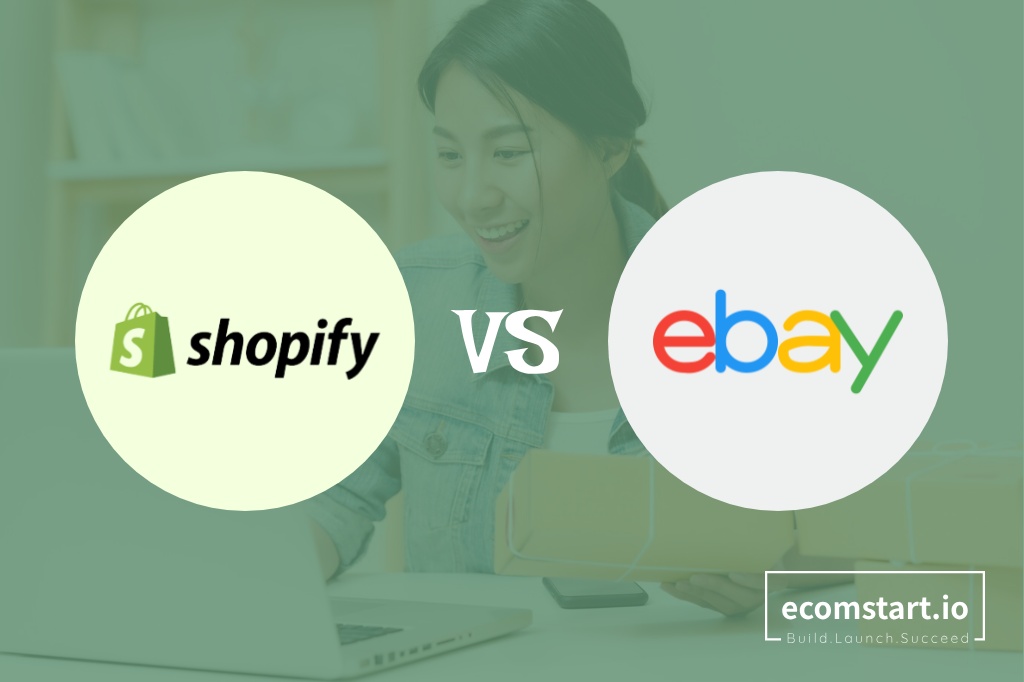
When starting your online store, choosing between selling on Shopify vs eBay can be a make-or-break decision for aspiring merchants. If you wonder whether to create a unique online store with Shopify or dive into eBay’s huge existing customer base, this blog is for you!
In this blog, we compare Shopify vs eBay and help you decide by analyzing the elements of these platforms, and show their pros and cons!
1. Key differences at a glance: Shopify vs eBay

Is Shopify like eBay? Let’s take a look at the differences between eBay and Shopify in the table below to find out!
| Feature | Shopify | eBay |
| Definition | A hosted eCommerce platform for building your own online store | An online marketplace where you can list and sell products alongside other sellers |
| Rating | Generally considered more versatile and scalable, but with a learning curve and potential cost consideration | Simpler and quicker setup, but with limitations on branding and customization |
| Pricing | Starts at $39/month + transaction fees | Listing and final value fees per sale |
| Target Audience | Businesses of all sizes, especially those seeking scalability, control, and advanced features | Individual sellers, small businesses, and those prioritizing quick setup and exposure to an existing audience |
| Design & Customization | Highly customizable with themes, layouts, and code editing | Limited customization options |
| Ease of Use | User-friendly interface with learning curve for advanced features | Simpler setup |
| eCommerce Features | Comprehensive features including product management, inventory control, marketing tools, payment processing, and analytics | Basic features for listing, selling, and managing orders |
| Marketing Tools | Built-in marketing features and app integrations for email marketing, social media marketing, and SEO | Limited marketing tools |
| App & Integrations | Extensive app store with integrations for various functionalities | Limited app selection |
| Scalability | Highly scalable to accommodate significant growth | Limited scalability |
What is Shopify?
Shopify is an all-in-one eCommerce platform that allows merchants to create, run, and manage online stores. With various impressive themes, built-in features, and third-party apps, users can create, customize, and enhance their eCommerce store without coding.
What is eBay?
eBay is an online marketplace where individuals and businesses can list and sell items. Buyers on this platform can browse through millions of listings, compare prices, and purchase products directly from sellers.
So what’s the difference between Shopify and eBay?
Shopify is an eCommerce platform that empowers merchants to create an online store with eCommerce features that help merchants increase sales, manage inventory and products, and establish brands. Thus, Shopify offers essential built-in eCommerce features and various apps with endless functions.
In contrast, eBay is a marketplace where buyers and sellers focus on facilitating transactions and offering a diverse product selection. That is why eBay offers restricted eCommerce features, customization options, and control capability.
2. Is Shopify better than eBay: A deep dive comparison
2.1. Shopify vs eBay: fees & pricing
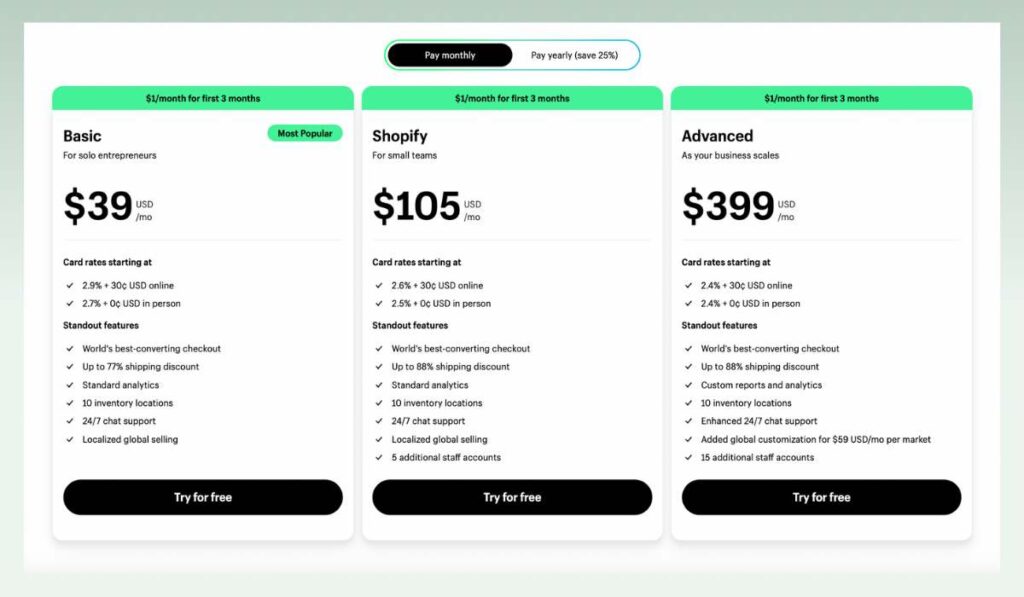
When using Shopify, you have to pay a monthly subscription fee. This eCommerce platform offers three main pricing plans: Basic, Shopify, and Advance, starting at $39 per month. Not only that, merchants must pay other costs to make sure that their stores run well.
- Domain: ~$10-15/year
- Apps: Depending on the apps and pricing plan, The average cost ranges from $30 to $150 monthly for small to medium stores.
- Themes: $0–$400.
- Payment gateway: Depending on your chosen plans and payment gateways, The basic Shopify charges 2.9% + $0.30 per sale, while the advanced one charges 2.4% + $0.30.
After considering these costs above, beginner retailers must pay at least $159 per month to set up and run a Shopify store.
For enterprises with over 1 million dollars in revenue annually, Shopify Plus is the best choice. The cost is pretty high, starting at $2,500 per month for standard setups and integrations.
Unlike Shopify, eBay doesn’t require a monthly subscription fee. However, merchants must pay listing and final value fees based on sales.

Every month, based on your seller level, you will have different numbers of free listings. For example, beginning sellers have 50 free listings per month, while higher-level sellers might have 250 or more.
However, specific listing formats, like auctions, and certain categories cannot be applied to free listings. After exceeding your free listing allowance, you have to charge for paid listings. This fee starts at $0.35 and varies depending on the category and listing format.
Besides listing fees, merchants have to pay final value fees that are accounted for in each sale when your products sell. The rate depends on the category and total sales price.
– 8% if the sale is over $150.
– 13.25% if it is less than $150, plus $0.30 per order.
– If your items are over $7,500, you have to pay:
- 3.25% on the first $7,500 of the sale price.
- 2.35% on the portion of the sale price above $7,500.
For example, when you sell an item for $100 with a 10% final value fee and a $0.35 listing fee, the total cost would be $10.35.
In conclusion, eBay can fit small businesses with a limited number of products and low sales. However, if your product and revenue volume increase, it can lead to rapidly escalating costs. Therefore, Shopify is more cost-effective for businesses with a large number of products and high-volume sales. Not only that, you don’t have to pay transaction fees when using Shopify Payments.
2.2. Design & customization

Shopify is an all-in-one solution with various impressive pre-designed themes and diverse pricing plans. The Shopify theme market has 180 themes, including 12 free themes and 168 paid ones that have prices ranging from $140 to $400. Not only that, merchants can find over 1900 Shopify themes and templates on the Themeforest marketplace.
Thanks to customization options, merchants can tailor fonts, colors, and layouts to fit their brand. However, these limited options don’t allow for extensive changes. To customize the store interface more deeply and add some eCommerce functions, you can use third-party apps on the Shopify app store.
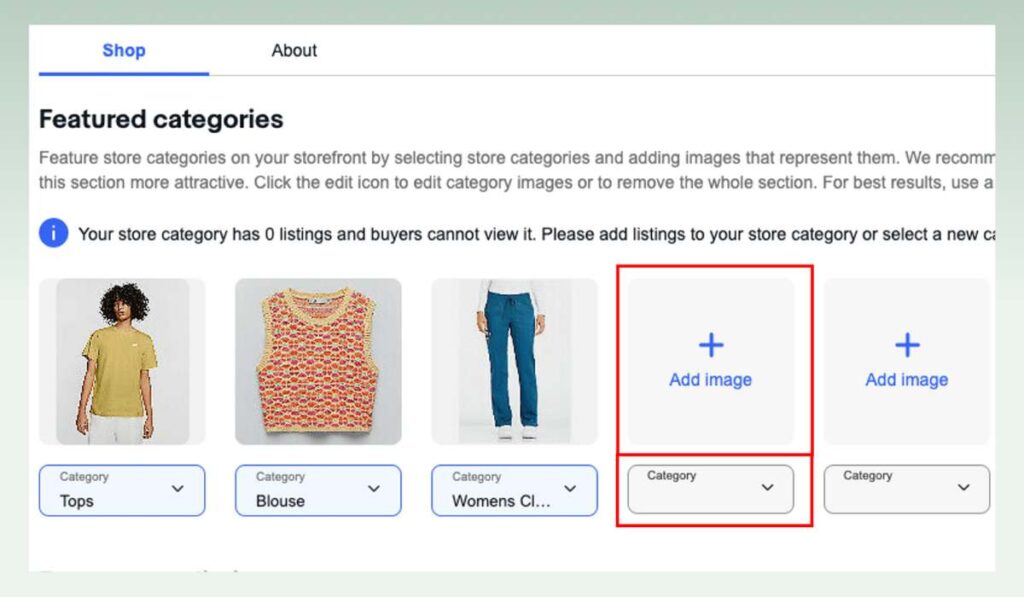
eBay is a marketplace; thus, it has limited customization capability. You can add a header image and change the color scheme to fit your branding, but that’s about it. Merchants cannot add other third-party apps to optimize their stores or change the layouts and fonts as they want. Retailers can adjust these elements below:
- Store name
- Main image
- Store logo
- Store description
- Featured categories
- Featured items
- Marketing banner
- Store video
- Store policies
In conclusion, Shopify provides a great deal more control and flexibility in terms of design and customization than eBay.
2.3. Ease of use
When setting up a Shopify store, merchants have to build online stores from scratch, from choosing a plan and themes to customizing the store interface, installing essential apps, and adding products.
The Shopify interface is simple and understandable for beginners; however, it takes some time for you to explore features and learn many things, like how to add products to the dashboard by using the left-hand toolbar and the use of third-party apps.
Shopify is suitable for non-tech-savvy retailers. But if you have a basic understanding of website management, even coding, you can customize some elements of your store more easily. Shopify also provides documents, tutorials, and support that help you learn more about Shopify features and deal with technical problems.
Setting up your store on eBay is easier. You don’t have to worry about choosing, setting, and using features because most of them are accessible through the platform’s interface.
The listing process is straightforward. You can quickly add product details, images, and descriptions without learning too much.
To sum up, setting up and running an eBay store is easier than a Shopify one. If you want to start selling online with a minimal setup and learning curve, eBay is the best solution for you.
2.4. eCommerce features

Shopify is an all-in-one eCommerce solution with impressive built-in features and diverse third-party apps with endless functionality. Thanks to these features, you can enhance and optimize your store to ensure robust performance and reliability with straightforward management processes.
When using Shopify, you don’t have to worry about product and inventory management. You can add, edit, and manage product information, adjust product variations, and import data as you want.
However, is it better to dropship on Shopify?
Yes, of course! With inventory management features, users can track inventory levels across various sales channels, set up inventory alerts, and even integrate with dropshipping services through third-party apps.
Not only that, powered marketing and sales tools on themes and apps can help you create and manage marketing campaigns and increase conversion rates and sales with promo banners, abandoned cart recovery, cross-selling, recommended products, reviews, etc.
Shopify also offers different features, including payment processing, customer management, analytics, and reporting, to enhance merchants’ stores.
On the other hand, eBay has limited eCommerce features. This platform offers restricted inventory and product management capabilities, like tracking basic sales and remaining inventory, inventory reports, and manual stock updates.
Maybe many merchants wonder that with this limited function, is it good to dropship on eBay. The answer is “Yes”. eBay assures that merchants can dropship when selling on their marketplace.

When selling on eBay, merchants mainly rely on search engine optimization on the platform and the existing eBay customer database. This platform offers limited built-in marketing tools and options for selling across multiple channels.
eBay has fewer payment options and basic customer management features. Merchants can only access basic sales reports with general data.
In conclusion, when comparing eCommerce features between eBay vs Shopify, you can see that Shopify is a perfect solution with robust built-in features and diverse third-party apps, from product management, inventory control, and marketing to customer engagement and data analysis.
2.5. Marketing tools
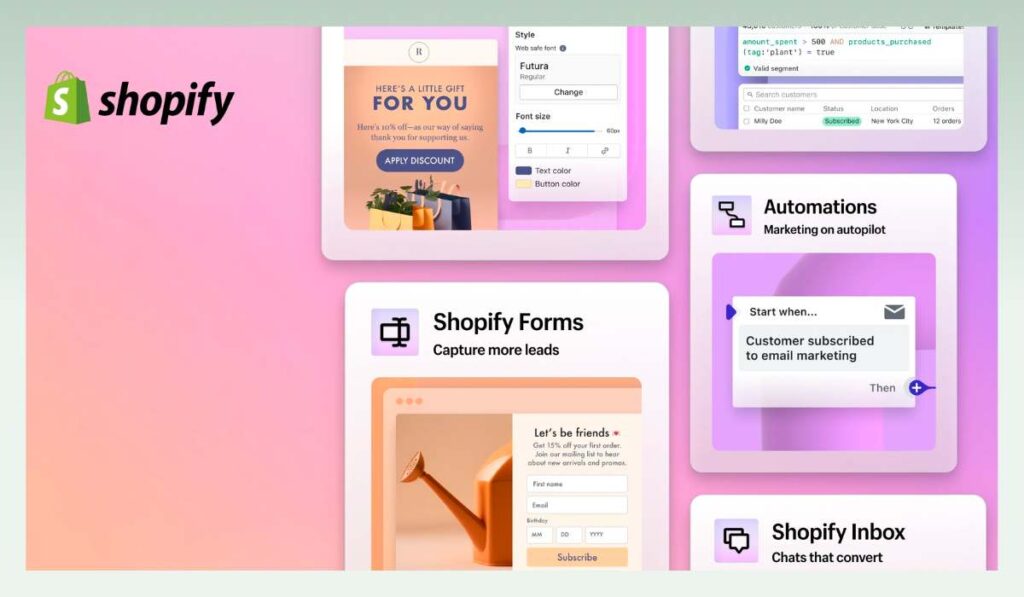
Shopify offers various marketing built-in features that help you increase your conversion rate, including reviews, promo banners, cross-selling, and recommended products.
If you prioritize expanding your customer base with advanced marketing campaigns and activities, Shopify is the most ideal eCommerce solution for you!
Thanks to a huge Shopify app marketplace, you can choose powerful third-party apps to support you in email marketing, discount and promotion campaigns, and social media activities.
You can integrate and use these apps effortlessly, which helps you save time to create a completed online store. However, they have limited customization. If you want to adjust the apps, you have to contact the app development teams.
Shopify has features like clear URLs, configurable title tags, and meta descriptions that are beneficial for search engines. However, it is limited to changing a website’s structure or canonical tags.
eBay provides basic email marketing functionality, restricted control over customer data, and limited analytics.
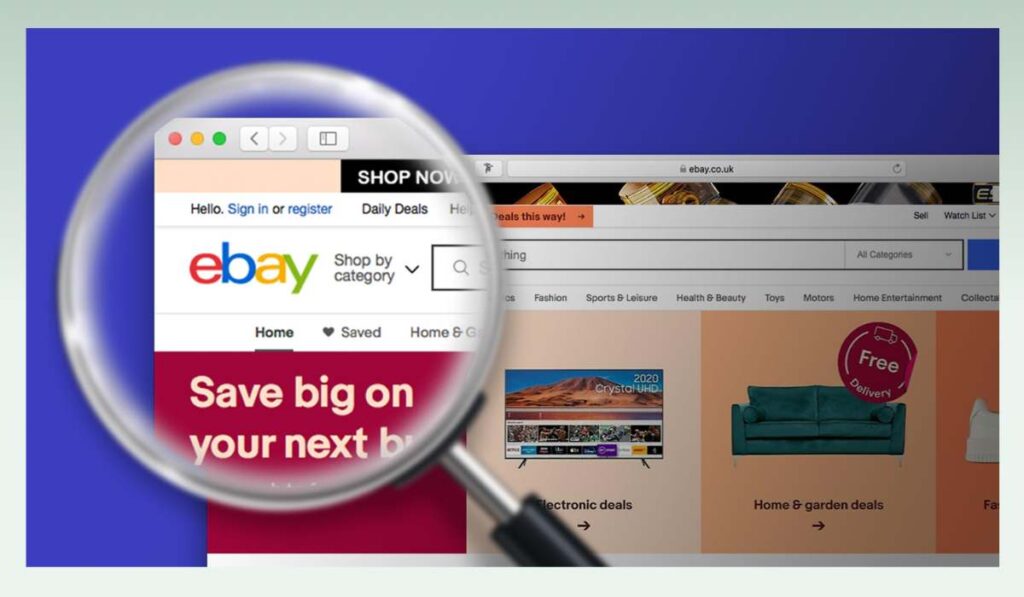
When selling on eBay, you mostly rely on eBay’s current user base and search engine optimization inside the platform for organic visibility. Merchants can have advantages for exposure within the eBay ecosystem but fewer options for reaching more customers outside of this marketplace.
To conclude, Shopify is the winner in terms of marketing features for merchants who want to expand their stores in multiple sales channels and broaden their customer base in different areas. However, if your target customers are eBay users, choosing eBay to start is a great idea!
2.6. App & Integrations
When running a Shopify store, merchants can access a huge app marketplace, including more than 8,000 apps with different pricing plans to enhance functions on websites. These third-party apps are user-friendly and compatible with the Shopify platform; thus, retailers can install and manage these apps directly within the platform.
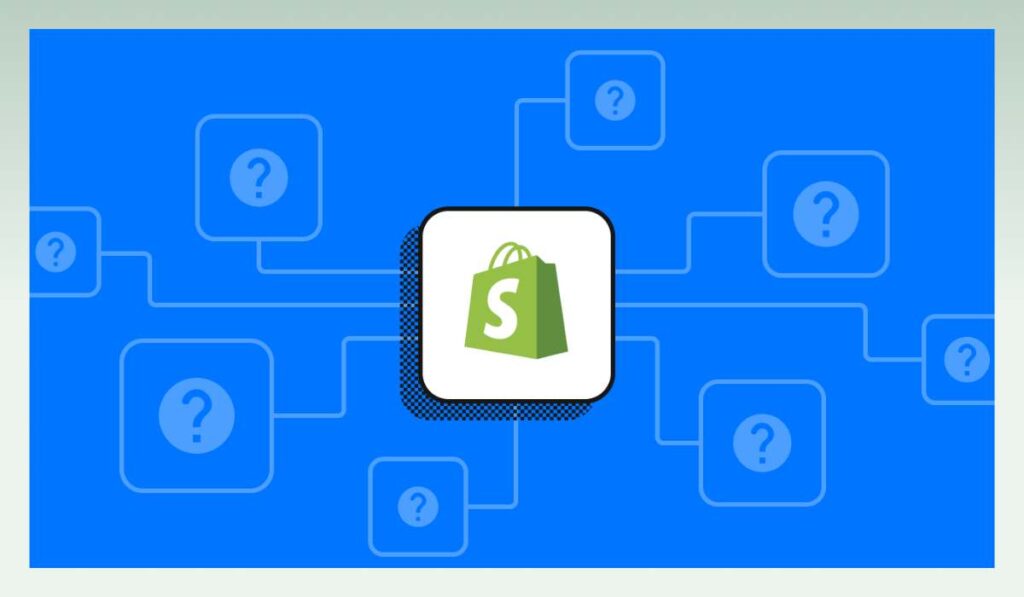
When your business grows, you can add new functionalities and choose higher pricing plans with more features to keep pace with your evolving needs.
In contrast, eBay offers a limited selection of third-party apps within the eBay platform, with restricted features relating to marketing, sales, and inventory management. Integrations are also limited to eBay-approved providers, resulting in less freedom and customization than Shopify’s open approach.
Overall, when comparing eBay vs Shopify, you can realize that Shopify offers a large range of app integrations, with greater flexibility and customization in building, managing, and enhancing your online store.
💡 Learn more: Shopify vs Amazon Showdown: Which Platform Leads in 2024?
2.7. Scalability
Shopify has robust features to accommodate significant growth. Thanks to its built-in features and diverse third-party apps, retailers can leverage these features to broaden their product categories, expand to new customers, and open new sales channels. Its app store is additionally filled with options to cater to niche markets as your company grows, and its open API allows for even more flexibility via customized integrations.
On the contrary, eBay’s limitations can become significant struggles for any business running an eBay store. This marketplace is suitable for individual sellers or beginning store owners who just want to target users on eBay. Restricted built-in functions and limited app selection prevent you from addressing complex business needs.
In conclusion, if you envision growth for your online store, Shopify is a great solution for you due to its superior scalability to meet the demand of complex stores.
3. Shopify vs eBay: Who holds the winning hand?
3.1. Pros and Cons of Shopify

Pros of Shopify
- Built-in eCommerce features
Shopify offers various necessary built-in features that help you run your store effectively, including a secure shopping cart, payment processing, inventory management, and order tracking.
If you want to increase sales? Don’t worry because Shopify provides essential sales and product features to help you optimize conversion rate, such as product listings, promo banners, cross-selling, and recommended products. With a detailed report dashboard, you can analyze data relating to inventory, products, sale channels, and customers to create effective strategies.
- Scalability
Shopify is designed to grow your business. With various features and third-party apps, you can help you to deal with increasing sales volume, product offerings, and customer base. If you want to expand your sales channels, you can use Shopify apps to connect marketplaces, social media platforms, and POS systems to your Shopify store and manage them all in one Shopify dashboard admin.
- Customization
When comparing customization capability between Shopify vs eBay, you can see that Shopify offers a higher level of customization through its theme store and various apps. With customization options of themes and diverse Shopify apps, you can build a unique online store reflecting your brand identity.
Cons of Shopify
- Additional fees
When comparing Shopify vs eBay fees, eBay’s fee structure is notably different. With Shopify, you’re required to pay monthly subscription fees along with additional charges for payment gateways and apps. It’s a small price to pay for the convenience, but it will come with a huge amount of money if you expand your business.
- Learning curve
Shopify is optimized for any retailer to start their store. However, merchants, especially individuals unfamiliar with eCommerce platforms, need time to learn about the platforms, features, and apps to know how to use them and how to optimize their stores with these functions.
- Setup time
When building an online store from scratch, you have to be involved in multiple tasks, from selecting a plan and theme, tailoring the website interface through customized options or apps, and adding products, to choosing and installing apps. It can take several days to build a complete store before publishing it.
In short, if you need an all-in-one solution, focus primarily on online sales, and want to expand your store in the future, Shopify is the best eCommerce solution for you.
3.2. Pros and Cons of eBay
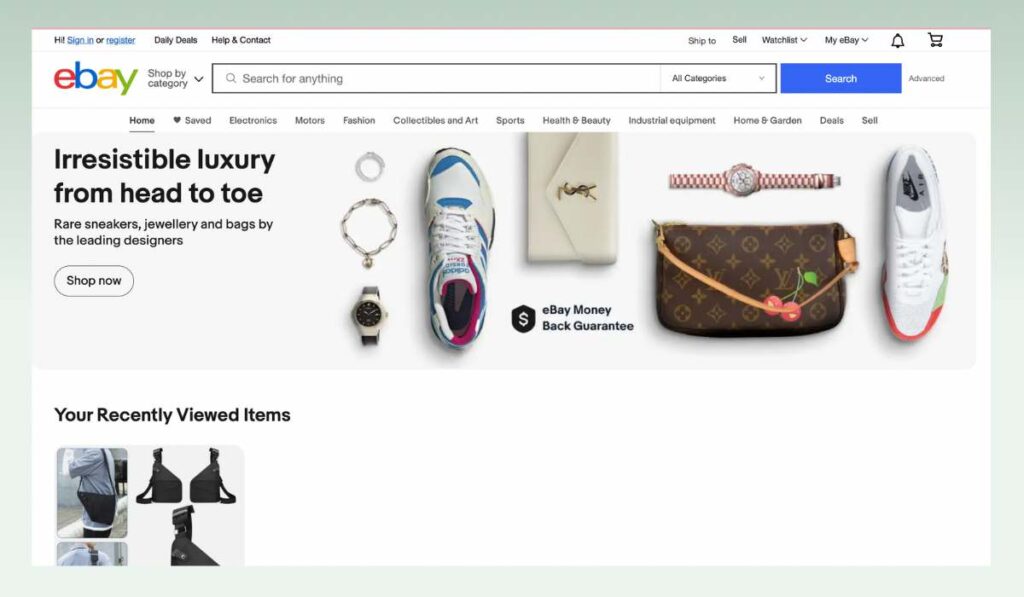
Pros of eBay
- Large existing customer base
eBay is the second largest marketplace in the world with over 129 million active users, according to Similarweb. When running a store on eBay, you can reach a massive user base and access a ready-made pool of potential buyers.
- Quick and easy setup
Compared to building and maintaining your online store from scratch with eCommerce platforms, running a store on eBay is quick and straightforward. You only adjust your name store, logo, store description, and list of your products. That’s all! Merchants don’t have to consider on theme and apps they use, learn how to use the apps and features, and customize their store to fit with brand characteristics.
- Lower initial cost
Unlike platforms with monthly subscriptions, apps, and theme fees, eBay retailers pay primarily for listing and final value fees based on sales. Thus if you start small, with a limited budget, you can run a store on eBay.
Cons of eBay
- Limited customization
Because you sell items on eBay, thus your store is displayed within the eBay framework. This platform restricts adjusting the store interface and adding various features to your store. Thus, you cannot create a unique customer experience and expand your brand image.
- Restricted eCommerce features and marketing tool
Unlike Shopify providing various built-in features and third-party apps, eBay offers basic and essential features for most products and inventory management. This platform provides general data, thus creating and implementing effective strategies for inventory and marketing is daunting.
- Limited scalability
Because this platform has restricted built-in functions and limited app selection, you will struggle when addressing complex business needs with high-volume sales and diverse categories. When running a store on eBay, you will rely on existing eBay users. It is hard for you to reach new customers outside the platform.
- High competition level
eBay, a platform with over 129 million active users, has a low barrier to entry, leading many retailers and individuals to open stores on this marketplace. According to Business of App, eBay has more than 18.3 million sellers! If you don’t have any strengths in terms of price, product quality, branding and marketing, customer service, etc., it will be very difficult to compete with other sellers.
In short, eBay is suitable for individual sellers and small businesses with a limited product range, prioritizing quick exposure to a large audience.
💡 Learn more: Shopify vs Ecwid (2024): A Clear-Cut Comparison for Merchants
3.3. Our verdict
“Is Shopify better than eBay?” “eBay or Shopify?”
The answer is based on your business goals, resources, and priorities. If you prioritize scalability and control and require diverse advanced features for marketing, sales, and inventory management, Shopify is a great solution for you.
However, if you are an individual seller or aspiring with a limited product range and restricted knowledge about eCommerce, want to save time in setting up, and target eBay’s existing user base, you should choose eBay to start your online store.
Looking to expand your eCommerce horizons beyond eBay? Explore ‘Shopify vs competitors‘ resources to uncover a plethora of alternatives. Discover various platforms, each with its own strengths and weaknesses. Choose the optimal platform to fuel your online store’s growth.
4. Shopify and eBay: Can we use them together?
But, what if you want to use both Shopify and eBay? If I want to start Shopify vs eBay dropshipping?
Luckily, there is a solution for you! You can integrate eBay with your Shopify store and manage both channels from one admin panel!
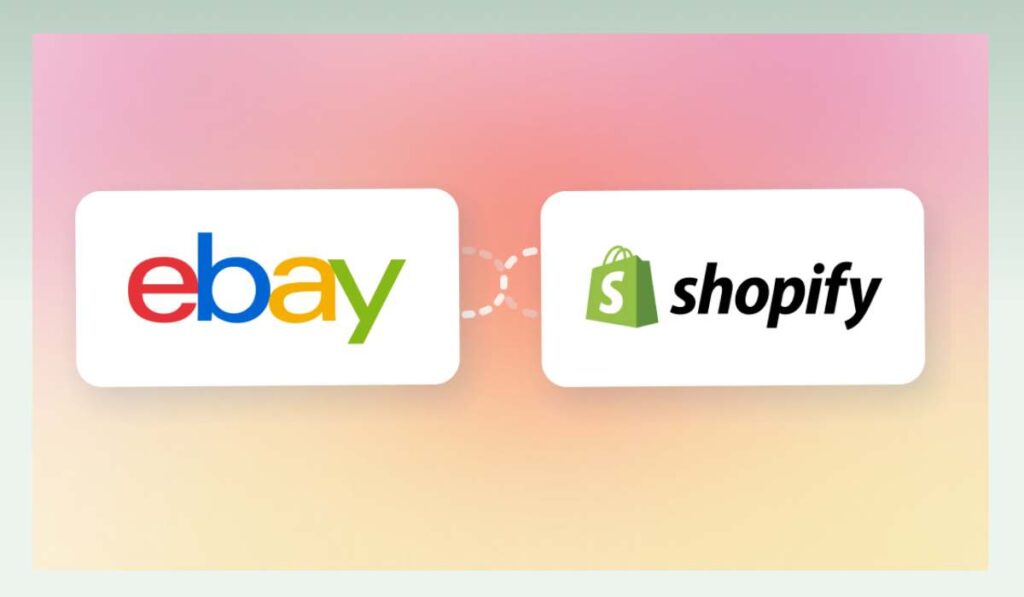
There are 5 easy-as-a-cake steps in Shopify and eBay integration:
- Step 1: Choose a suitable integration app on the Shopify app marketplace and click “Install app”.
- Step 2: Connect your eBay account through the app.
- Step 3: Access your eBay account and permit access.
- Step 4: Import your products from eBay to Shopify
- Step 5: Test your integration and handle issues
5. Conclusion
Running a Shopify vs eBay store has different pros and cons. To choose a suitable solution, merchants need to consider their targets, resources, and priorities. If you are an individual who wants to start an online store with a limited budget, eBay is ideal for you. But if you dream of having your own brand and scaling up your store in the future, creating a website with Shopify is the greatest solution.
After reading the blog above, you can understand more about eBay vs Shopify and find an appropriate way to dive into the eCommerce world.
To help you level up your business, eComStart brings valuable and practical knowledge. Don’t forget to subscribe to eComStart!
6. FAQs


